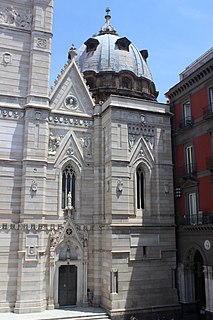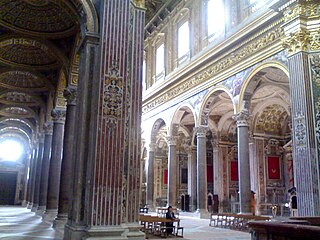
Giulio Cesare Fontana (12 February 1580, Rome - 9 June 1627, Naples) was an Italian architect and engineer, mainly active in Naples and its surroundings.

Giulio Cesare Fontana (12 February 1580, Rome - 9 June 1627, Naples) was an Italian architect and engineer, mainly active in Naples and its surroundings.
He was the son of Elisabetta Paduschi and her husband, the architect Domenico Fontana. He trained in the studios headed by his father, his uncle Giovanni Fontana, his cousin Carlo Maderno, Matteo Castelli and Girolamo Rainaldi. He and his father travelled to the Kingdom of Naples to design the Dogana nuova (1594) and the crypt of the Duomo di Salerno and the Duomo di Amalfi - Giulio Cesare was director of works on both these crypts until 1612. He also summoned Bartolomeo Picchiatti from Ferrara as a collaborator. [1]
In 1607, following his father's death, he became chief royal architect of the Kingdom, restoring Castel Nuovo and leading work on the Palazzo Reale. That same year he took part in the competition to design the Royal Chapel of the Treasure of St. Januarius organised by the Deputazione della Real Cappella del Tesoro. Other competitors included Ceccardo Bernucci, Giovan Battista Cavagna, Francesco Grimaldi, Giovanni Cola di Franco, Michelangelo Naccherino, Dionisio Nencioni di Bartolomeo and Giovan Giacomo Di Conforto. A commission in Rome judged the competition and the designs by father Grimaldi and Giovanni Cola di Franco were declared the winning entries.
In 1612 viceroy Pedro Fernández de Castro, count of Lemos, commissioned him to convert the former cavallerizza into the Palazzo dei Regi Studi, which now houses the Museo Archeologico Nazionale di Napoli - nel frattempo operò nella sistemazione dei Regi Lagni. Around the same time he designed the grain pits in Largo Mercatello (now Piazza Dante) in Naples and worked on the Regi Lagni. In 1626 he designed the portale dell'Annunziata gateway in Aversa, took part in completing the oratory of San Carlo Borromeo near the church of Sant'Anna dei Lombardi - that church also contains the funerary monument to Domenico Fontana, designed by Giulio Cesare in 1627 but badly damaged during World War Two. [2]

Domenico Fontana was an Italian architect of the late Renaissance, born in today's Ticino. He worked primarily in Italy, at Rome and Naples.

The Accademia di San Luca, was founded in 1577 as an association of artists in Rome, with the purpose of elevating the work of "artists", which included painters, sculptors and architects, above that of mere craftsmen. Other founders included Girolamo Muziano and Pietro Olivieri. The Academy was named after Saint Luke the evangelist who, legend has it, made a portrait of the Virgin Mary, and thus became the patron saint of painters' guilds.

Ferdinando Fuga was an Italian architect who was born in Florence, and is known for his work in Rome and Naples. Much of his early work was in Rome, notably, the Palazzo della Consulta (1732–7) at the Quirinal, the Palazzo Corsini (1736–54), the façade of the Santa Maria Maggiore (1741–3), and the Church of Sant'Apollinare (1742–8). He later moved to Naples and notably designed the Albergo de'Poveri (1751–81), the façade of the Church of the Gerolamini, and that of the Palazzo Giordano.

Sant'Anna dei Lombardi,, and also known as Santa Maria di Monte Oliveto, is an ancient church and convent located in piazza Monteoliveto in central Naples, Italy. Across Monteoliveto street from the Fountain in the square is the Renaissance palace of Orsini di Gravina.

Santa Maria dei Miracoli presso San Celso is a church and a sanctuary in Milan, Lombardy, northern Italy.

Giovanni da Nola (1478–1559), also known as Giovanni Merliano, was an Italian sculptor and architect of the Renaissance, active in Naples.

Giovanni Battista Cavagna, also known as Cavagni or Gavagni was an Italian architect, engineer, and painter mainly in Naples, but also in Rome and Ascoli Piceno, Italy.

The Royal Chapel of the Treasure of St. Januarius, or the Reale cappella del Tesoro di San Gennaro, is a chapel located in the Cathedral of Naples, Italy, and dedicated to St. Januarius, patron saint of the city. This is the most lavishly decorated chapel in the Cathedral, and contains contributions by the premier Baroque artists in Naples.

Santa Maria della Verità is a church in rione Materdei, in the quartiere of Stella of Naples, Italy. The entry is located on Via San Agostino degli Scalzi, number 6.

The church of Santi Severino e Sossio and the annexed monastery are located on via Bartolommeo Capasso in Naples, Italy.

Michelangelo Naccherino was an Italian sculptor and architect, active mainly in the Kingdom of Naples, Italy.

Santa Maria del Parto a Mergellina is a church located in the quartiere of Chiaia in Naples, Italy. The church is peculiarly perched on top of a private building, and accessed by a stairway, placed behind a restaurant located in piazza Mergellina.

The Palazzo Zevallos Stigliano is a Baroque palace located on Via Toledo number 185 in the quartiere San Ferdinando of central Naples, Italy. It is also called the Palazzo Zevallos or Palazzo Colonna di Stigliano, and since 2014 serves as a museum of artworks, mainly spanning the 17th through the early 20th centuries, sponsored by the Cultural Project of the bank Intesa Sanpaolo. This museum is linked to the Museum or Gallerie di Piazza Scala in Milan and the Museum at Palazzo Leoni Montanari in Vicenza, also owned by the Bank.
Bartolomeo Picchiatti was an Italian engineer and architect. A short street in the Soccavo area of the city is named after him.

Palazzo di Sangro, also known as either Palazzo de Sangro di Sansevero or Palazzo Sansevero, is a late-Renaissance-style aristocratic palace facing the church of San Domenico Maggiore, separated by the via named after the church, in the city center of Naples, Italy. Part of the palace facade faces the piazza in front of the church, which is also bordered to the south by the Palazzo di Sangro di Casacalenda.

Onofrio Antonio Gisolfi was an Italian engineer and architect, active from 1637 until his death.
Giovanni Cola di Franco was an Italian Mannerist architect active between 1596 and 1621, mainly in Naples, where he was born and died. He collaborated with contemporary architects such as Francesco Grimaldi, Bartolomeo Picchiatti and Giovan Giacomo Di Conforto.

Dionisio Nencioni di Bartolomeo was an Italian architect, mainly active in Naples, to which he moved in 1584. He worked on the Hieronymite church from 1587 until his death, in collaboration with Giovanni Antonio Dosio.